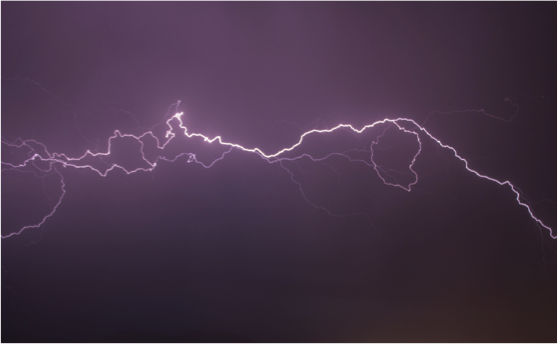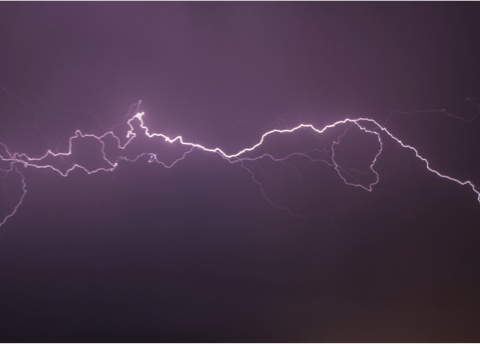 Lightning is known to be the most significant source of surges—bolts have been recorded to have a million to a billion volts and between 10,000 to 200,000 amps. However, lightning only makes up a portion of all transient events in a facility.
Lightning is known to be the most significant source of surges—bolts have been recorded to have a million to a billion volts and between 10,000 to 200,000 amps. However, lightning only makes up a portion of all transient events in a facility.
Because transients can originate from both external sources (like lightning) and internal sources, facilities ought to have both a lightning protection system and surge protection installed.
This begs the question: what is the difference between these two systems, and how do they work together?
Lightning Protection System
Quite simply, a lightning protection system protects a structure from a direct lightning strike.
To do this, an air terminal (or system of air terminals) is placed in the most probable position to capture the direct strike, based on the structure’s architectural design and roof equipment. The rest of the system is designed to safely convey that electrical energy from the lighting strike to ground as efficiently and safely as possible.
To intercept the strike and conduct the high current energy of a lightning strike into the earth, system components include the:
- Air terminal, which is used to intercept the lightning strike.
- Down conductors, providing the most direct path possible to move the electrical energy towards the ground.
- Grounding system, which provides a path for the current to dissipate into the ground and out of harm’s way.
- Bonding, meant to reduce the possibility of voltage differences that are a safety risk.
Lightning protection standards ensure how to properly place air terminals, run cable, ground and bond in order to ensure maximum safety in this energy transfer and dissipation.
Surge Protective Device (SPD)
A surge protective device (SPD) is designed to protect electrical systems and equipment from surge and transient events by limiting transient voltages and diverting surge currents.
What causes transients and surges?
Lightning is the most spectacular form of an externally generated surge, however, it is estimated that 65% of all transients are generated internally within the facility by the switching of electrical loads such as:
- Lights
- Heating systems
- Motors
- Office equipment
How does a SPD work?
There is at least one non-linear component of the SPD, which under different conditions, transitions between a high and low impedance state. At normal operating voltages, the SPDs are in a high impedance state and do not affect the system. When a transient voltage occurs on the circuit, the SPD moves into a state of conduction (or low impedance) and diverts the transient energy and current back to its source or ground. This limits or clamps the voltage amplitude to a safer level. After the transient is diverted, the SPD automatically resets back to its high impedance state.
What Sets the Two Systems Apart?
On a basic level, the lightning protection system protects the facility and structure from direct strikes, while SPDs protect electrical equipment and systems against surges or transients.
How the two operate, and the components involved, also vary. Lightning protection system components are always in place and ready to function, while SPDs monitor internal system voltages and spring into action if a transient voltage occurs on the circuit.
How the Two Work Together
Though lightning is not the most common transient event, it is the most significant. While a lightning protection system protects the exterior against the affects of lightning, SPDs must be in place to support the other system and the related transients a strike creates. SPDs will activate and begin to conduct energy into the grounding system if surges to bonded equipment exceed the designated rating.
Lightning is the most likely external cause of a significant surge, and SPDs must be installed to limit currents entering into the internal environment, showing the importance of an interconnected facility electrical protection system.
Lightning protection standards—such as National Fire Protection Association (NFPA) 780, UL 96A, LPI 175, IEC and BS standards in the handbook—outline the special considerations for SPDs for use with lightning protection systems.
Essentially, a surge protector device must be rated for use with the lightning protection system according to its Nominal Discharge Current, or the peak value of In (8/20 μs) that the SPD can still function at after 15 applied surges. According to UL 96A, for example, service entrance SPDs must have a Nominal Discharge Current rating of 20 kA.
Not all UL listed SPDs are necessarily rated for use with a lightning protection system. What this rating means is that it can handle greater surges than devices with a lower In rating.
Learn More About Comprehensive Electrical Protection
Lightning and surge protection are two elements of an effective electrical protection system. Download the nVent ERICO Lightning Protection Handbook for an in-depth look at the comprehensive system and its components.
Image credit: Pexels

